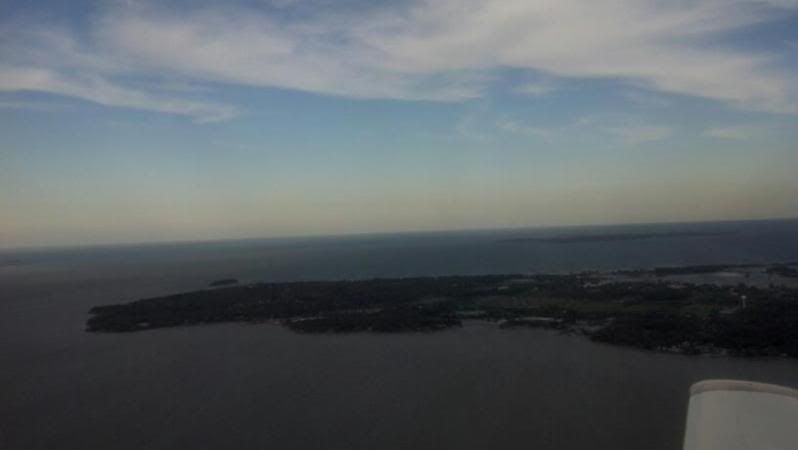 Thanks: 0
Thanks: 0
 Likes: 0
Likes: 0
Results 1 to 10 of 14
Thread: allgie
-
10-10-2011, 07:36 AM #1
 allgie
allgie
whats going on with the lake?
-
10-10-2011, 09:11 AM #2
 algea growth
algea growth
The algea growth bloom is coming from a wet Sept and the runnoff from farm fields, chemicals from lawns and farms, sewage systems overloaded ( human ****) and flowed straight into tributaries and the lake. I was in it Saturday around the islands and it looks thick and dark colored and in patchy streaks. A biologist said it will be like this for a month yet. Its gotten worst over the last few years and something needs done. The algea has moved into Lorain area waters this week and extends just west of the islands. Algea is feeding off the stuff I mentioned above. Just not sure how it will affect the fish over time. The cure ? Wish I knew , but probably stiff regulations on chemicals and sewage is a great start. I have nothing against farmers, but something needs changed for the good.
Capt. Greg
-
10-10-2011, 09:24 PM #3
 pea soup
pea soup
3 reports in the last few days state current bloom is worst recorded. see sandusky register tomorrow. the first few years i chartered mid seventies it was also very bad. remember green boat wakes for miles. phosphorous from fertilizer runnoff is only part of the problem, it acts like a fuel and feeds the algae, sewage and the interaction between zebra, quagga muscles, also contribute, relaxed regulations havn't helped things either. if left unchecked it can and will harm our great fishery.Recent strong winds and heavy rain has helped clear maumee bay and area west of west sister, warmer water makes that location bloom first, you also get more farm runnoff from the Maumee and Detroit rivers into the western basin. now that the bloom has pushed east of the islands the papers have really started to pick it up! Capt Ed
Last edited by eriepro; 10-10-2011 at 09:35 PM. Reason: add more text
-
10-11-2011, 12:14 AM #4
 Algea
Algea
I live near Grand Lake St. Marys and have seen first had what algae growth can do to the water.
And how it can cause sickness to people and fish.
Last year a lot of fish died in that lake.
It was a little better this year because of public awareness and actions that were taken but its going to take a long time to stop the problem .
I hate to see this starting in Lake Erie, everybody who cherishes fishing there needs to raise A lot of H**L about the bloom. And bring it to the attention of the public before the lake ends up like some other smaller lakes in Ohio.
-
10-17-2011, 09:27 PM #5

This weekends windy conditions appeared to have blown the algea out of here. The water looked much nicer today when I was up flying, this is Catawba Island point and you can see Kellys in the background.

-
10-18-2011, 12:12 PM #6

I work in the fertilizer industry directly with Farmers. I can say that over the last 10 years the usage of phosphate based fertilizers has dropped every year. Phosphourous bonds very tightly to the soil particles in the ground. The only way for it to run off is for the dirt to run off. In the spring of the year with heavy rains this is typically a problem...look at the satelite images in april and may. By June, the rains are sporadic enough that there is very little runoff out of the fields. When you look at the tile drains in ditches during june july august rains they predominantly run fairly clear. Exceptions are the abnormally heavy rains we have had this past september. Also in the last 10 years the amount of acres that have had drainage done to them has shot through the roof. This fact is contributing more to the issues with the Lake Erie watershed than any other single factor. Farmers see immediate economic benefits from tiling, and right now farming is a very profitable business and most are doing whatever they need to increase the productivity of their ground.
I am not saying that other areas cause all the problems with the lake, but Farmers are not needlessly overapplying fertilizers. Commercial phosphate fetilizer has become increasingly costly and trust me the farmers watch their pennies and spend their money in areas of their operations that benefit them the most. Drainage is the number one area of a farm that will make money for a farmer.
I didn't mean to stir up a hornet nest here, but wanted to put an opinion in from the ag industry. Trust me I love to fish way more than I like to work....so I am for protecting the lake in practical manners.
-
10-18-2011, 04:37 PM #7

Troy--You kept mentioning phoshpates--what about Nitrogen in terms of either Ammonia or Ureas or UAN. And explain drainage a tad more?? Are you saying farmers have spent money to get rain water off their farms and into nearby creeks which flow into rivers which flow into Lake Erie?? We all know Corn uses a ton of nirtorgen, more than any other crop and soybeans makes it's own nitrogen so little used by soybean farmers??
-
10-18-2011, 05:29 PM #8
 Guys here is some Food for thought
Guys here is some Food for thought
This lake drains into the St. Marys River and ends up in Lake Erie, how much gets added along the way? Lake St. Marys was just like Lake Erie years ago a good place to fish and when I first noticed it I didn't think to much about it. But now when I see what has happened to Lake St. Marys I fear what is happening on Erie.
Kudos to our Watershed Hero's
Editorial: Grand Lake Saint Marys is text book mess
By the Dayton Daily News | Tuesday, July 20, 2010, 05:09 PM
The ecological and economic tragedy at Grand Lake St. Marys is stunning. Think of Ohio’s largest inland lake like a bathtub. If runoff loaded with phosphorous from manure and fertilizer keeps flowing into the tub, eventually the water is going to turn so foul, you won’t want to get in it. And anything good in it will die. Cyanobacteria feeds on the phosphorous, which sucks the oxygen — and the life — out of the water. Grand Lake St. Marys is an especially sensitive lake. Water flows slowly through the 13,000-acre reservoir, meaning it only gets “flushed” every 18 months. In addition, the lake doesn’t have a lot of islands or channels, which prevent erosion and filter out bad stuff. Most significant, the state’s largest concentration of animal farms are nearby. Manure-tainted runoff is poison to the lake, and it has been building up over decades. With government now telling people not to go near the water, Grand Lake St. Marys’ tourism business is dead. That’s as much as a $200-million-a-year industry. That business, however, pales in comparison to the local agricultural industry, which is estimated at $675 million. Needless to say, agri-business has intense clout. In a way, Grand Lake St. Marys is Ohio’s BP disaster. The damage isn’t nearly as extensive, but the cleanup will take years. Moreover, people are feeling their way because no one has a formula for fixing something that’s been so violated. Unlike the oil spill in the Gulf, however, Grand Lake St. Marys didn’t get fouled in an instant because a specific piece of equipment failed. It happened because multitudes of people failed — over years. The algae blooms have become more frequent, and even as efforts have been made to limit pollution, there was no sense that time could run out.
Some people are comparing Grand Lake St. Marys to Indian Lake. Indian Lake is also shallow and man-made, vulnerable to similar threats. Even setting aside the differences — that Indian Lake recharges more quickly, that it has more shoreline, that row crops are more prevalent in that region than manure-producing animal farms — it, too, could be on life-support today. But locals came together years ago — the agricultural community and people who valued the lake — and figured out what had to be done differently. One observer notes that both communities live under the same laws, but, in one case, something was preserved; in the other, something was allowed to be destroyed. It’s hard not to see the different results as statements about local leadership.
At this point, experts are still trying to get their arms around the extent of the problem, whether there’s a way to clean up the lake, and how much it might cost. If alum is poured on the water, if dredging equipment is brought in, the fix will be expensive, running into the millions. That money won’t come from the local community, but from the federal and state governments. (Just on Tuesday, the federal government kicked in $1 million.) Whatever is done, all of us will be paying for the fact that the Grand Lake St. Marys community couldn’t come together on how to protect a resource, and neither the federal or state environmental protection agencies knocked heads when people decided to do too little.......The one sure thing is that everyone will have a long time to work out differences. No amount of money can fix Grand Lake St. Marys quickly
-
10-18-2011, 07:22 PM #9

One of the major contributors to the western end is the maumee river where the city of toledo dumps their sewage into the river. The city pays regular penalties to the EPA for runoff, but the penalties are far cheaper than proper repair. Those who have the power constantly look the other way as penalty money continues to flow into their bank accounts. The Toledo sewer system
was outdated many years ago, were told not to expand and make necessary repairs but nothing has ever been done, "can't afford it" is the attitude, however they keep expanding the system and collecting more sewage from outlying areas and nothing is done about it. More than half of lake eries problems come from the maumee river and another major contributor is the ottawa river next door. These two make up roughly 75% of the mess in the lake, but nothing is being done except more studies.......
Airshot
-
10-18-2011, 10:12 PM #10
 Clarifying the Toledo Story
Clarifying the Toledo Story
It is agreed and true that Toledo is one of many serious sources, but not accurate that nothing is being done and not true that EPA is looking the other way. In 2002, after being sued by US and then Ohio EPA (under basis of 1972 Federal Clean Water Act), Toledo signed a consent decree agreeing to a $500 million plan - yes that is spend $500 million on a long term control plan. The first step was doubling of their Bayview sewage plant capacity, (including a 25 million gallon holding basin for storm events) and since 2006 all flows reaching that plant have been treated. They have 25 separate projects on line in the plan. 8 are today under construction, 7 are in design phase, the rest are scheduled in the consent decree signed by the city, EPA, and the courts. The schedule for the rest requires completion within the next 9 years. True, not overnight, but then 60% of remaining projects are started or in design, and $500 million ain't chicken feed. So it is inaccurate that they and EPA aren't doing anything on that part of the problem.
All the details and facts are available for the looking at:
http://www.toledowaterwaysinitiative.com/about/
-








 Reply With Quote
Reply With Quote



I forgot to set the alarm last...
Fishing with Dave and...